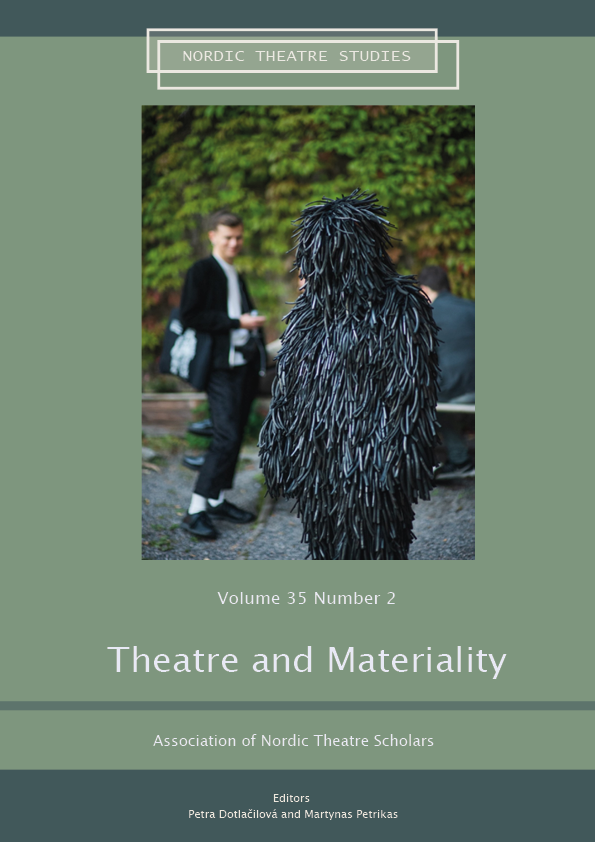What Kind of Bodies Will Come Together in Passage 468?
DOI:
https://doi.org/10.7146/nts.v35i2.149659Keywords:
open body, closed body, agential realism, sensory field, intra-actionAbstract
The aim of this article is to investigate the question, whether the performance of Passage 468 (2019), as interpreted through the theory of agential realism by Karen Barad and the concept of sensory field by Petri Tervo, could suggest a revised conception of the open body. First, the objective of the text is to review the literature concerning the conceptions of the open body by Bakhtin as part of the carnival culture, and the closed body by Elias as a result of the civilising process. Additionally, I make some remarks about how the open body is considered in theatre history. Secondly, I investigate the analysis of the performance by describing my experience as a spectator of being part of certain sensory fields that were opened up in Passage 468. I argue that the sensory field is akin to staggering away from the safety of identity which determines the way in which we perceive and categorize the different aspects of a performance as separate entities. Finally, I suggest that by translating the sensory field experience into written form as a part of performance analysis, it is possible to understand how different bodies are entangled in the phenomena of the body. As I propose, in this way it is possible to once again conceive of the body and approach it as open and collective.
References
Bahtin, Mihail. 2002. Francois Rabellais. Keskiajan ja Renessansin nauru. Translated by Tapani Laine and Paula Nieminen. Keuruu: Otava.
Bartling, Scott. 2015. Beyond Language: Viktor Shklovsky, Estrangement, and the Search for Meaning Art. PhD thesis in Slavic Languages and Literatures, Stanford University, Stanford, California. https://stacks.stanford.edu/file/druid:wk536ws4497/Beyond%20Language%20(final)-augmented.pdf (17.9 2023).
Barad, Karen. 2003. “Posthumanist Performativity: Toward an Understanding of How Matter Comes Matter.” Journal of Women in Culture and Society, vol. 28, no 3. 801-31.
Barad, Karen. 2007. Meeting the Universe Halfway. Quantum Physics and the Entanglement of Matter and Meaning. Durham and London: Duke University Press.
Bristol, Michael D. 1985. Carnival and Theatre. Plebeian Culture and The Structure of Authority in Renaissance England. New York and London: Routledge
Braidotti, Rosi. 2019. Posthuman Knowledge. Medford, MA: Polity.
Burkitt, Ian. 1991. Social selves: theories of the social formation of personality. London: Sage.
Carlson, Marvin. 2003. “The Golden Age of The Boulevard”. In Joel Schechter (ed.). Popular Theatre: A Source Book. London: Routledge, 22-31.
Damasio, Antonio. 2000. Tapahtumisen tunne. Translated by Kimmo Pietiläinen. Helsinki: Terra Cognita.
Elias, Norbert. 1939/1994. The Civilizing Process. Sociogenetic and Psychogenetic Investigations. Translated by Edmund Jephcott. Oxford: Blackwell
Enqvist, Kari. 2005. “Mitä valo on?” Duodecim 121(23), 2513-9. https://www.duodecimlehti.fi/duo95365 (17.9.2023).
Fischer-Lichte, Erika. 1997. The Show and the Gaze of Theatre: A European Perspective. Iowa City : University of Iowa Press
Haraway, Donna. 1985/2016. A Cyborg Manifesto. Science, Technology, And Socialist – Feminism in The Late Twentieth Century. Minneapolis: University of Minnesota Press. https://warwick.ac.uk/fac/arts/english/currentstudents/undergraduate/modules/fictionnownarrativemediaandtheoryinthe21stcentury/manifestly_haraway_----_a_cyborg_manifesto_science_technology_and_socialist-feminism_in_the_....pdf (17.9 2023).
Hillman, David. 2005. “Homo Clausus in Theatre”. In Bryan Reynolds and William N. West (eds.). Rematerializing Shakespeare. London: Palgrave McMillan, 161-85.
Hurley, Erin. 2010. Theatre and Feeling. London: Palgrave McMillan.
Isherwood, Robert M. 1981. “Entertainment in Parisian Fairs in the Eighteenth Century”. Journal of Modern History, Vol.53, No. 1, 24-48.
Jürs-Munkby, Karen. 2007. “Hanswurst and Herr Ich: Subjection and Abjection in Enlightenment Censorship of the Comic Figure”. New Theatre Quarterly 23:2, 124-35.
Massumi, Brian. 1995. “Autonomy of Affect.” Cultural Critique No. 31, The politics of systems and environments Part II, 83-109.
Pepperel, Robert. 2003. The Posthuman Condition: Consciousness Beyond the Brain. Bristol: Intellect Book.
Salminen, Antti. 2015. Kokeellisuudesta. Historiallisesta avantgardesta jälkifossiiliseen elämään. Helsinki: Osuuskunta Poesia.
Schechner, Richard. 2016. Johdatus esitystutkimukseen. Translated by Sarianna Sihvonen. Helsinki: Taideyliopiston. Teatterikorkeakoulun julkaisusarja.
Silde, Marja 2020. “Onko kritiikki arvonantoa vai kulutuslogiikkaa?” Teatteri&Tanssi+Sirkus 1/2020, 23-26.
Tervo, Petri. 2017. “Huomioita mimesiksestä, väkivallasta ja identiteetistä”. https://kumu.info/huomioita-mimesiksesta-vakivallasta-ja-identiteetista/ (17.9 2023).
Tervo, Petri and Marja Silde. 2014. “Esitys ja ekphrasis: eli kuinka kuvata esiin luuranko esityksen kaapista.” Esitys, Vol 1, 34-8.
Tervo, Petri and Marja Silde. 2016. “Kokemuksen klubilla.” Näyttämö & tutkimus, Vol. 6, 260-79.
Weimann, Robert. 2000. Author’s Pen, Actor’s Voice. Playing and Writing in Shakespeare’s Theatre. Edited by Helen Higbee and William West. Cambridge: Cambridge University Press.
Wiles, David. 2011. Theatre and Citizenship. Cambridge: Cambridge University Press.
Downloads
Published
How to Cite
Issue
Section
License
The copyright belongs to the authors and Nordic Theatre Studies. Users can use, reuse and build upon the material published in the journal but only for non-commercial purposes. Users are allowed to link to the files, download the files, distribute the files on a local network (preferably by links), upload the files to local repositories if their institutions require them to do so, but not republish the files without proper agreements with the journal and the author.

